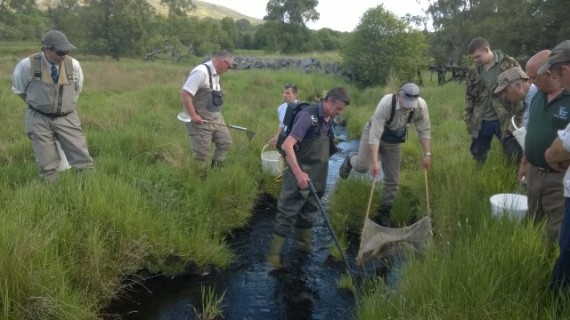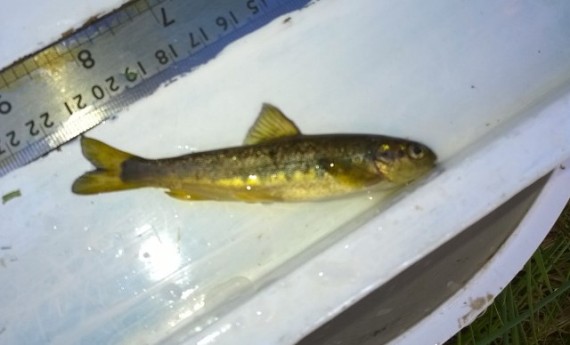I should begin this blog with an apology for the lack of news from the research team recently; a combination of solid fieldwork during the summer weeks and house renovations at home has left little time for updates. Hopefully normal service will be resumed from now on - there is a bit of a backlog to publish!
This blog will focus on the mainstem juvenile monitoring which is such a prominent and important part of our work. It’s importance is a reflection of the quantity, and quality, of available habitat in the Spey mainstem. Our primary monitoring technique for assessing the mainstem are a series of replicate salmon fry index surveys conducted mainly in shallow riffle or run habitat i.e. salmon fry habitat. These sites are surveyed annually for three minutes (actual electrofishing time counted down by the Efishing kit). The main target species and life stage is salmon fry but we also catch parr plus other species such as trout, eels etc.
The Efishing backpack was purchased in 2012 and the sites have been surveyed in a consistent manner since. The salmon fry index results from these surveys over the last five years are shown below.

Spey mainstem salmon fry index results 2012 to 2016 (number of salmon fry per minute). Results are ordered from the lower river (top of table) to the upper limit of salmon distribution above Spey Dam (bottom of table).
Looking at the results as a whole the mean salmon fry counts in 2016 were the lowest in the sequence, although the pattern was not consistent across the river. We normally begin these surveys in the lower river and it was obvious from the first day of surveying this summer that the fry counts in the lower reaches not as high as recorded in recent years. This remained the case until we reached the sites upstream of the Avon confluence. The Avon joins the Spey between sites S096R1 and S104L2. Upstream of the Avon the results were better, more akin to those recorded in previous years. The change in the colour coding in this area of the river should be apparent from the table above. Note that the colour coding ranges from red (lowest 20% of results) to dark green (highest 20% of results) with amber, yellow and light green between.
Looking in more detail the average fry count in sites downstream of the Avon confluence was 10.8/min in 2016 compared to over 20/min in each of the preceding three years. Upstream of the Avon confluence, to Spey Dam, the mean count in 2016 was 21.7/min, just below average for the last five years and the third best mean count for this part of the river. There were some good results in this part of the river with much more green in the colour coding.
Upstream of Spey Dam should really be treated separately as the fish passage problems known to exist at Spey Dam have their own impact on fish numbers in what should be extremely valuable spawning grounds for early running grilse and salmon. In 2016 we found that salmon fry were limited in distribution upstream of the dam, the greater prevelence being in the upper reaches; the opposite of the more normal situation when counts are usually higher in the lower reaches, closer to the dam.
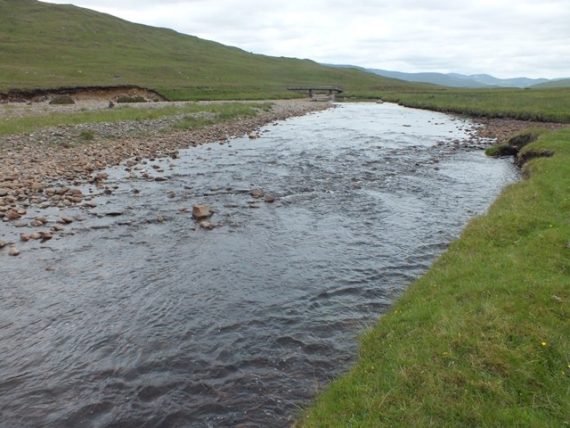
An example of the typical good spawning habitat available in the very upper reaches of the Spey mainstem, in this case, a short distance downstream of the Allt Yairack confluence.
The picture therefore is one of lower fry counts, better in the upper mainstem; although it is worth noting that overall the counts were only a little lower than recorded in 2012.
Salmon parr are also captured during these surveys. The salmon parr counts are shown in the table below. The survey sites are a combination of historic sites (some of which had been surveyed for a number of years prior to 2012, although with different electrofishing equipment, which cruically lacked the in-built timer) to more recentlt selected sites. Habitat quality varies across the sites with some more suited to fry than parr and vica versa. A good example of this habitat variation can be seen in the part of the river from the lower Abernethy site (S163L1) to the Kingussie area (S254R1). Here substrate sizes are dominated by pebble rather that cobble and boulder. The larger substrates normally provides more cover (hidey holes) for parr whereas the smaller fry can find shelter within, or alongside, smaller material. Whilst parr counts are generally low in this part of the river the fry counts are generally good - reflecting habitat suitability at our survey sites.
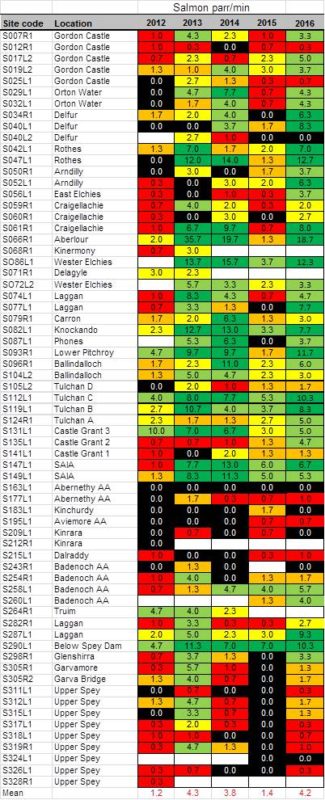
In contrast to the lower mean fry counts the parr counts in 2016 were almost the best in the sequence, beaten only by 2013. If the results from the river upstream of Spey Dam are excluded the parr counts downstream of Spey Dam were 4.9/minute compared to 4.6/min in 2013. That year was one of the few when good parr counts were recorded above the dam. Interestingly these findings chime with comments made by anglers and many ghillies this year who have remarked on the greater numbers of parr seen rising and latching on to small flies.
In addition to the network of timed sites on the mainstem we have also, since 2014 at least, completed semi-quantitiative surveys at three sites in the mainstem; at Aberlour, Blacksboat and Advie. These sites are quadrat sites, in relatively stable habitat with the site boundaries defined by boulders. These sites are completed at the end of the summer survey season and provide an opportunity for cross referencing with the timed surveys. I have commented before on the need to understand the size distribution of the salmon parr and consequently the proportion of the parr stock that is likely to smolt the following year. These end of summer surveys in the mainstem provide the sort of data we need to investigate this issue. Incidentally semi-quantitative surveys means those involving a single run through the site and in this case without stop nets (it would be virtually impossible to set up stop nets in a quadrat site in the mainstem anyway).
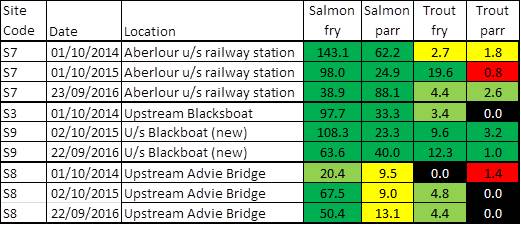
Results from the semi-quantitative surveys in the mainstem 2014-2016 (density per 100m2). In two out of the three sites the salmon fry densities were the lowest in the sequence in 2016, matching the general findings from the salmon fry index surveys. And, similarly, the salmon parr densities were the highest in the sequence at all three sites.
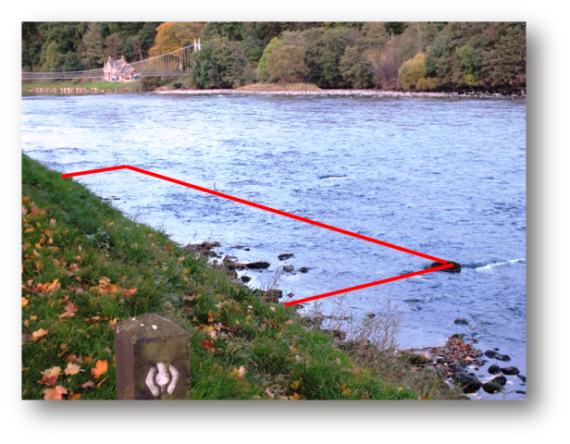
Site S7 in Aberlour. This site has been surveyed in exactly the same way for the last three years at the end of the summer. 100 salmon parr were captured within the marked area, with many more evading capture within the luxuriant fronds of ranunculus which grows so well in this area.
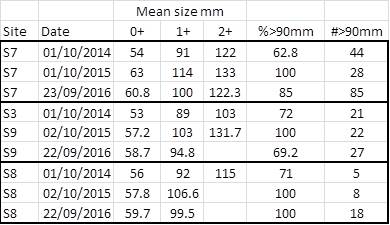
This table provides data on the mean length of each size class along with the proportion of salmon parr likely to smolt the following spring. For example in site S7 (Aberlour) 85% of the parr were larger than 90mm (the end of summer size threshold likely to result in smolting). Within that site the actual number of pre-smolt parr was also 85; twice the number recorded in the 2014, the year with the second highest count. In each of the three sites, even though the mean parr length were smaller than recorded in 2015, the actual number of pre-smolt parr was the highest in the sequence, although with only three years data it is not really a long term series - yet.
The results presented here today are therefore mixed. Salmon fry counts in the lower mainstem are lower than recorded in recent years but the parr counts, and densities, in the mainstem appear to be good, indicating thaat the mainstem should produce a healthy smolt run in 2017. The parr of course need to survive the winter; some level of mortality is inevitable with the main risks being extreme flows (although maybe less of an issue during the winter), predation and the avaibility of overwinter habitat.
Potential reasons for the reduced salmon fry counts in the lower mainstem this year will be the subject of the next blog; but from discussions with other biologists it is clear that this is not a phenonema unique to the Spey.
The post Mainstem electrofishing survey results 2016 appeared first on Spey Fishery Board.
Spey Fishery Board







